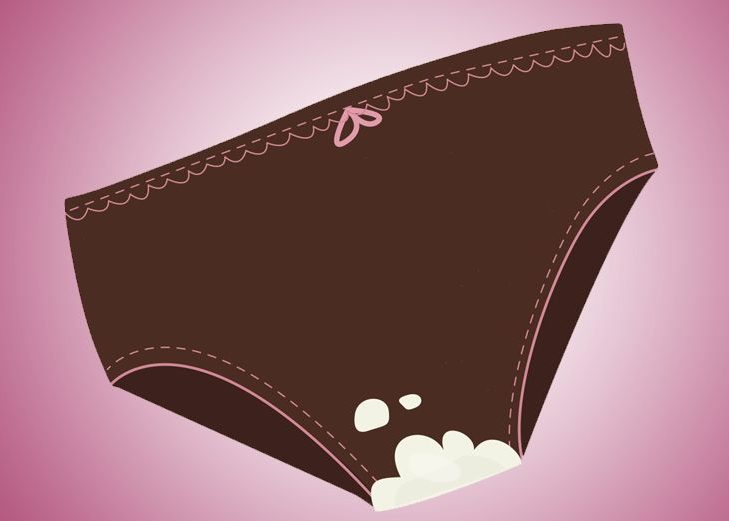What is white discharge?
White discharge comes out of the vagina. It is sticky and white/creamy or transparent. It appears at puberty and gradually disappears after the menopause. They are a natural sign of good health and mean that your organs are working properly. All women have them and they play an important role.
In general, if your discharge doesn’t itch or smell bad, you’re fine.
White discharge, or leucorrhoea, is made up of :
- cervical mucus, secreted by the cervix ;
- cells from the vagina ;
- good bacteria.
The presence of white discharge is due to the activity of the female hormone estrogen. The amount of discharge varies according to the time of the cycle, and increases at ovulation.
What is the purpose of white discharge?
The main role of white discharge is to clean your vagina by eliminating dead cells and germs. It also contains antibodies that keep bacteria and viruses out of your body.
You don’t need to clean your white discharge because it’s “clean”. On the contrary, it’s dangerous to wash the inside of your vagina or put perfume on your panties, as this could cause irritation.
How can I tell if my white discharge is normal?
To find out if your white discharge is normal, look at its colour, smell and texture.
If your discharge has no particular smell, is white or cream-coloured and fluid, it’s normal. If, on the other hand, you notice white balls, it’s best to consult a midwife or gynaecologist.
If your discharge is brown or slightly red, it’s probably the start or end of your period: this is normal. If it continues for several days, you can consult a midwife or gynecologist.
However, it’s best to consult a gynecologist or midwife if your discharge :
- have a strong odour
- is no longer white but green or yellow,
- is itchy
- is particularly thick and sticky.
It could be an infection, and only a professional can tell you. Rest assured, it happens to all women and there are simple, effective treatments.
If you have any questions, with WeerWi, on the app, the website or Facebook, you can talk anonymously with a virtual counselor 24 hours a day or with a midwife from the Lydia call center from 7am to 10pm (call or whatsapp messages).
* To find out more: everything you need to know about white discharge
What we learned during our Instagram live chat with Maimouna Diop, midwife at Marie Stopes International.
White discharge is a NORMAL vaginal secretion that coats the lining of the vagina, which is what you’ll find at the bottom of your pants at several stages of your cycle.
They help to keep your vaginal flora in good working order, a sort of protective barrier that keeps the vagina healthy and protects it from external aggressions (dust, bacteria). Nature is good, the vagina cleans itself!
White discharge has a more or less thick, sometimes slimy texture, depending on the different stages of your cycle, and does not have an excessive odour. Its consistency is often compared to rice paste. If it’s more like egg white, you’re probably in a fertile period, but calculate your cycle carefully to be sure. You can use the WeerWi app to do this.
A brief chronology of the variations in vaginal discharge throughout your cycle:
Phase 1: menstruation. During the first few days of the cycle – which corresponds to the first few days of your period – it’s rare to see a white discharge because it’s mixed with blood and menstrual waste. Just after your period, the discharge is absent, dry or pasty.
Phase 2: pre-ovulation. The discharge – or cervical mucus – is fluid, sticky and white, resembling a lotion.
Phase 3: ovulation. The discharge is much heavier, wet, gelatinous, slippery, clear and stretchy like egg white.
Phase 4: after ovulation and up to the first day of the next period (known as the premenstrual phase). The discharge becomes sticky, pasty and/or dry again.
NO WORRIES, every woman and every body is unique, so your discharge may vary and not correspond exactly to this chronology.
If your discharge has an unpleasant or very strong odour, if it is yellow, grey or even green, if it changes texture radically or if your private parts itch or burn, this may be a sign of infection and we advise you to consult a specialist. It happens to all women and is easily treated using the products recommended by your doctor.
How can you avoid an infection?
Maintain good hygiene by washing your hands well before touching your genitals or going to the toilet to avoid introducing germs into your vagina. It’s hot and sometimes humid, so wear cotton underwear that allows your genitals to breathe properly, and avoid wearing lace or nylon briefs or thongs for too long. Your vagina needs to breathe!
Remember: the vagina cleans itself. It doesn’t need special intimate gels, which are often too aggressive for the vaginal flora and will do you more harm than good. Nor do you need to insert your finger inside your vagina to clean it. Once or twice a day, simply run clear water over the outside of your vulva (the external part of your genital organ) and gently rub an ordinary soap over the surface to clean it – that’s all you need! When you have your period, change your menstrual protection every 3 or 4 hours to limit the risk of infection and toxic shock, especially with disposable pads.
White discharge is a sign that your private parts are in good health. Get to know them and you’ll feel better about yourself ☺
Source : Gaëlle Baldassari, Toubibadakar & Hello Clue



